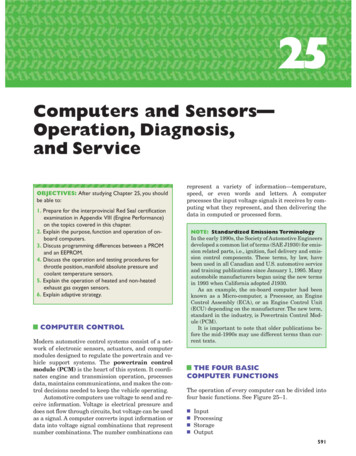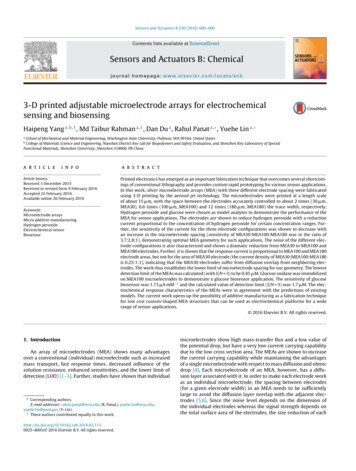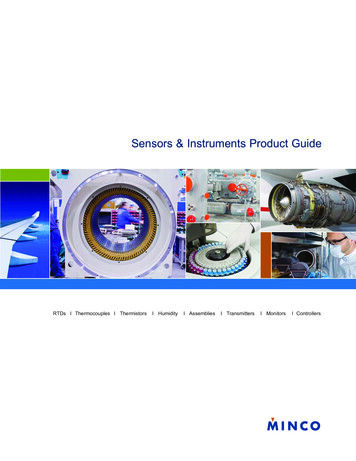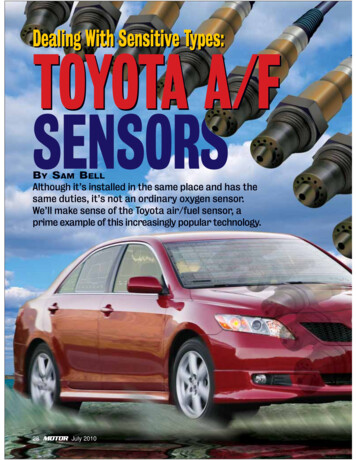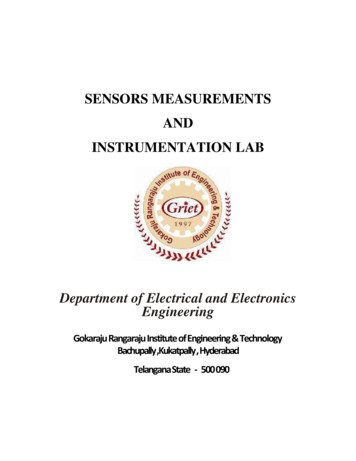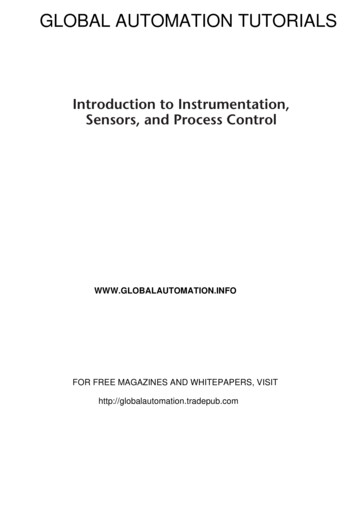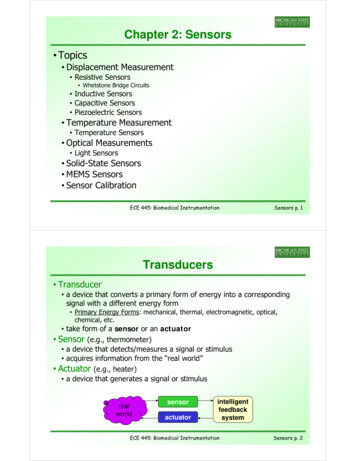
Transcription
Chapter 2: Sensors Topics Displacement Measurement Resistive Sensors Whetstone Bridge Circuits Inductive Sensors CapacitiveCiti SensorsS Piezoelectric Sensors Temperature Measurement Temperature Sensors Optical Measurements Light Sensors Solid-State Sensors MEMS Sensors Sensor CalibrationECE 445: Biomedical InstrumentationSensors p. 1Transducers Transducer a device that converts a primary form of energy into a correspondingsignal with a different energy form Primary Energy Forms: mechanical, thermal, electromagnetic, optical,chemical, etc. takea formoofo assensorso oor aan actuatoru o Sensor (e.g., thermometer) a device that detects/measures a signal or stimulusreal worldworld” acquires information from the “real Actuator (e.g., heater) a device that generates a signal or stimulusrealo dworldsensoractuatorintelligentfeedbacksystemtECE 445: Biomedical InstrumentationSensors p. 2
Sensor SystemsTypically interested in electronic sensor convert desired parameter into electrically measurable signal General Electronic Sensor primary transducer: changes “real world” parameter into electricalsignalginto analogg or digitalg secondaryy transducer: converts electrical nsduceranalogsignalusablevaluessensor Typical Electronic Sensor “System”inputsignal(measurand)sensor dataanalog/digitalsensormicrocontrollersignal processingcommunicationnetworkdisplayECE 445: Biomedical InstrumentationSensors p. 3Example Electronic Sensor Systems Components vary with application digital sensor within an instrument microcontroller signal timing data storagesensorµCsensorsignal timingmemorydisplayhandhelda d e d instrumentst u e t analog sensor analyzed by a PCsensor interfacesensorkeypade.g., USBA/D, communicationsignal processingPCcomm. card multiple sensors displayed over interneti tinternettsensorprocessorcomm.sensor busPCsensor buscomm. cardECE 445: Biomedical Instrumentationsensorprocessorcomm.Sensors p. 4
Primary Transducers Conventional Transducerslarge, but generally reliable, based on older technology thermocouple:hl temperature differencediff compass (magnetic): direction Microelectronic Sensorsmillimeter sized, highly sensitive, less robust photodiode/phototransistor: photon energy (light) infrared detectors,detectors proximity/intrusion alarms piezoresisitve pressure sensor: air/fluid pressure microaccelerometers: vibration, -velocity (car crash) chemical senors: O2, CO2, Cl, Nitrates (explosives) DNA arrays: match DNA sequencesECE 445: Biomedical InstrumentationSensors p. 5Direct vs. Indirect Measurement Direct Measurement: When sensor directly measures parameter of interest Example, displacement sensor measuring diameter of blood vessel Example, ? Indirect Measurement: When sensor measures a pparameter that can be translated into theparameter of interest Example, displacement sensor measuring movement of a microphonediaphragmdap ag to quantifyqua t y liquidqu d movemento e e t throught oug thet e heartea t Example, ?ECE 445: Biomedical InstrumentationSensors p. 6
Displacement Measurements Many biomedical parameters rely on measurements of size, shape, andposition of organs, tissue, etc. require displacement sensors Examples (direct) diameter of blood vessel (indirect) movement of a microphone diaphragm to quantify liquid movementthrough the heart Primary Transducer Types Resistive Sensors (Potentiometers & Strain Gages)Inductive SensorsCapacitive SensorsPiezoelectric Sensors Secondary Transducers Wheatstone Bridge Amplifiers (next chapter)ECE 445: Biomedical InstrumentationSensors p. 7Potentiometer Potentiometers produce output potential (voltage) change inresponse to input (e.g., displacement) changes typicallyt i ll formedfd withith resistivei ti elementslt e.g. carbon/metalb / t l filmfil V I R produce linear output in response to displacement Example potentiometric displacement sensors Translational: small ( mm) linear displacements vo increases as xi increases Single-Turn: small (10-50º) rotational displacements vo increases as i increasesECE 445: Biomedical InstrumentationSensors p. 8
Strain Gage: Basics Consider: strain (stretch) a thin wire ( 25 m) its length increases and its diameter decreases results in increasing resistance of the wire Can be used to measure extremely small displacements, onthe order of nanometers For a rectangular wire Rline L Lli A A wt resistivity,AtwL conductivity Thus R/R L/L – A/A / ECE 445: Biomedical InstrumentationSensors p. 9Strain Gage: Gage Factor Remember: for a strained thin wire R/R L/L – A/A / A (D/2)2, forf circulari l wireiDL Poisson’s ratio, : relates change in diameter D to change inlength L D/D - L/L Thus R/RR/R (1 2 )(1 2 ) L/LL/L / /dimensional effectpiezoresistive effect Gage Factor, G, used to compare strain-gate materials G R/R (1 2 ) / L/L L/LECE 445: Biomedical InstrumentationSensors p. 10
Strain Gage: Materialsmaterialgage factor, GTCR (10-5)Ni80 Cr202.1 - 2.610Pt92 W83.6 – 4.424Silicon (n type)-100 to -14070 to 700Germanium (p type)102TCR temperature coefficient of resistivity (ºC-1) Note: G for semiconductor materials 50-70 x that of metals due to stronger piezoresistive effect semiconductors have much higher TCR requires temperature compensation in strain gageECE 445: Biomedical InstrumentationSensors p. 11Strain Gage Unbonded strain gage: end points are anchored but materialbetween end points is unbonded Bonded strain gage: material is cemented to strained surface Unbonded strain gage diaphragm pressure strain @ B & C strain @ A & D Bonded strain gage((a)) resistivei i wirei(b) foil type(c) helical wire temperature compensationanchor points unbonded ‘dummy’ strain gage direction of max sensitivity ?ECE 445: Biomedical InstrumentationSensors p. 12
Wheatstone Bridge Wheatstone bridge is a configuration variable and fixedelements used to monitor small variations in the elements(and optionally compensate for temperature effects) Consider first: resistive voltage divider Voutt varies as RT changes readout method for 1 element sensor 1 variable/sensor element bridge configuration R3 is sensor elementR4 set to match nominal value of R3If R1 R2, Vout-nominall 0Vout varies as R3 changesVCC- R1 R4ECE 445: Biomedical InstrumentationSensors p. 13Wheatstone Bridge Balanced bridge Vout 0 occurs when R1/R2 R4/R3VCC which is also R1/R4 R2/R3 mid-node voltages must be equal Single element sensor- R3 Ro (1 x), x factional change in resistance of sensor if R1 R4 Vout- VCC/20.6 if R2 Ro Vout VCC (Ro(1 x) / Ro(2 x)) 0.4 Vout VCC((1 x) / (2 x)) VoutVout is same, only VoutVout increases with x Vout VCC ((1 x)/(2 x) – 1/2) Two element (half bridge) R1 & R3 increases/decrease together if R2 R4 Ro and R1 R3 Ro(1 x)0.21E-15Voutt/Vcc Vout increases as x increases Vout VCC/2 when x 0, VCC when x -0.204-0.41-element-0.62-element-0.8-1-11.22-1 -0.8 -0.6 -0.4 -0.20x0.2 0.4 0.6 0.8 Vout- VCC/(2 x), Vout VCC((1 x) / (2 x)) Vout VCC (x/(2 x)) increasing positive values of x cause Vout to become more positiveECE 445: Biomedical InstrumentationSensors p. 141
Wheatstone Bridge Two element (half bridge); alternativeVCC R1 R4, R3 increases when R2 decreases (and visa versa) if R1 R4 Ro,R1 R4 Ro R3 Ro(1 x) and R2 Ro(1R2 Ro(1-x)x) - Vout- VCC/2Vout VCC ((1 x)/2) Vout VCC ((1 x)/2 – 1/2)increasing positive values of x cause Vout to become more positive0.6 Four element full bridge change opposite of R1 & R3 if R1R1 R3 Ro(1 x)R3 Ro(1 x) and R2R2 R4 Ro(1-x)R4 Ro(1 x) Vout ? Vout- ? Vout ?0.40.21E-15Voout/Vcc R1 & R3 increases/decrease together R2 & R4 decrease/increase togetherdiscuss relativeperformanceof 64-element-0.82-element-1-1.2-1 -0.8 -0.6 -0.4 -0.2ECE 445: Biomedical Instrumentation0x0.2 0.4 0.6 0.8Sensors p. 15Wheatstone Bridge Full bridge configuration all bridge elements are variable (sensors) increasingii & decreasingdi elementslt arrangedd tot maximizei i sensitivityiti it Example: unbounded strain gage B and C operate togetherA and D operate togetherRy and Rx used to balance the bridgeoutput vo Ri voltmeteroltmete inteinternalnal resistanceesistanceBA Temperature CompensationCD When all R’s from same material TCR of all elements cancel changehini temperaturett no changehini outputt t voltageltECE 445: Biomedical InstrumentationSensors p. 161
Semiconductor Strain Gage Semiconductors make highly sensitive strain gages have higher gage factors than metals/alloys more temperature sensitive than metals/alloys less linear than metals/alloys Semiconductor strain gage options bulk semiconductor material p-type: positive gage factor n-type: negative gage factor lightly doped material gives high gage factor diffused/doped/ p semiconductortop viewside viewECE 445: Biomedical InstrumentationSensors p. 17Semiconductor Strain Gage Integrated planer multi-element strain gage Example: diaphragm pressure sensor strain gage (resistors) integrated into the surface when pressure is applied, diaphragm bends outer strain gages stretch and inner gages compress Wheatstone bridge configuration high sensitivity & good temperature compensationECE 445: Biomedical InstrumentationSensors p. 18
Semiconductor Strain Gage Cantilever-beam force sensor 2 piezoresistors in top and two in bottom of a semiconductor beam when force F is applied R1 & R3 (on top) are compressed R2 & R4 (on bottom) are stretched can be read out with Wheatstone bridgeECE 445: Biomedical InstrumentationSensors p. 19Pressure Sensor: Biomedical Application Disposable blood-pressure sensorECE 445: Biomedical InstrumentationSensors p. 20
Biomedical Applications of Strain Gages Extensively used in cardiovascular and respiratorymeasurments dimensionaldiil determinationsd ti ti plethysmographic (volume-measuring) determinationsbridge output(b) venous-occlusionplethysmography(c) arterial-pulseplethysmographystrain gage on human calf OtherO h stuffff to knowk elastic strain gage is typically linear with 1% for 10% of maximalextension thus,hstrain gages are onlyl goodd measuring smallll displacementsd lECE 445: Biomedical InstrumentationSensors p. 21Inductive Displacement Sensors Inductance, L n2G n number of turns in coil G geometric form factor effective permeability of the medium Varying any of these 3 parameters can be used to measuredi ldisplacementt off a magneticti coreECE 445: Biomedical InstrumentationSensors p. 22
Capacitive Sensors Capacitance, C A/x dielectric constant A area of capacitor plate x plate separation distance Generally, displacement sensors rely on changes in x Sensitivity,Siti it K,K tot x isi K A/xA/ 2 higher sensitivity for devices with smaller separation motivation of microsensors ManyMmethodsh d forf capacitanceireadoutd switched capacitor amplifier may cover later example:l dc-exciteddi d circuiti i when capacitor stationary no current through C V1 E when x C, C Vo V1 - EECE 445: Biomedical InstrumentationSensors p. 23Piezoelectric Sensors Piezoelectric materials generate electric potential whenmechanically strained or visa versa UsedU d tot measure physiologicalh i l i l displacementsdi lt andd recordd hearth tsounds Modes of operationp thickness (longitudinal) compressiontransversal compressionthickness-shear actionface-shear action Equivalent circuit model deflection x charge qsensorcablesamp K constantECE 445: Biomedical InstrumentationSensors p. 24
Piezoelectric Sensors: step response Simplified circuit model combined C’s and R’s replace charge gengen. with current Step response for displace x at time T exponential decay due to leakage through internal resistance note: piezoelectric devices have 1G-ohm internal resistances decay and undershoot can be reduced by increasing RC time constantECE 445: Biomedical InstrumentationSensors p. 25Temperature Measurement Temperature is extremely important to human physiology example: low temperature can indicate onset of problems, e.g., stroke example: high temperature can indicate infection Temperature sensitive enzymes and proteins can be destroyedby adverse temperatures Temperature measurement and regulation is critical in manytreatment planspECE 445: Biomedical InstrumentationSensors p. 26
Temperature Sensor Options Thermoelectric Devices most common type is called Thermocouple can be made small enough to place inside catheters or hypodermic needles Resistance Temperature Detectors (RTDs) metal resistance changes with temperature Platinum,, Nickel,, Copperpp metals are typicallyypy used positive temperature coefficients Thermistors (“thermally sensitive resistor”) formed from semiconductor materials, not metals often composite of a ceramic and a metallic oxide (Mn, Co, Cu or Fe) typically have negative temperature coefficients Radiant Temperature Sensors photon energy changes with temperature measured optically (by photo detector) Integrated Circuit (IC) Temperature Sensors various temperature effects in silicon manipulated by circuits proportional to absolute temperature (PTAT) circuit: Si bandgap f (Temp)ECE 445: Biomedical InstrumentationSensors p. 27Temperature Sensor Options Comparison of common temperature sensorsECE 445: Biomedical InstrumentationSensors p. 28
Thermocouples Seebeck-Peltier Effect dissimilar metals at diff. temps. signal electromotive force (emf) is established by the contact of two dissimilarmetals at different temperatures Thermocouple features: rugged and good for very high temperatures not as accurate as other Temp sensors (also non-linear and drift)ECE 445: Biomedical InstrumentationSensors p. 29Thermistors Heavily used in biomedical applications base resistivity: 0.1 to 100 ohm-meterscan be made very smallsmall, 500um diameterlarge sensitivity to temperature (3-4% / ºC)excellent long-term stability Resistance vsvs. temperature keep current low to avoid self-heatingECE 445: Biomedical InstrumentationSensors p. 30
Electromagnetic Radiation Spectrum Visible light wavelength 400-700nm Shorter wavelengths ultraviolet, 100nm x-ray, 1nm gamma rays, 0.1nm01( 1Å)( 1Å) Longer wavelengths infrared IR: broad spectrum near IR, 1000nm000 1 m thermal IR, 100 m far IR, 1mm microwave, 1cmmicrowaveradar, 1-10cmTV & FM radio, 1mAM radio,radio 100mECE 445: Biomedical InstrumentationSensors p. 31Radiation Thermometry Radiant power of an object is related to its temperature makes it possible to measure temperature without physical contact at body temperaturestemperatures, radiant spectrum in far infraredspectral transmission of materialsspectral radiant emittance &% off ttotalt l energyinfrared spectrum:p 0.7 to 300 mspectral sensitivity of photon and thermal detectorsECE 445: Biomedical InstrumentationSensors p. 32
Human Temperature Measurement Radiation thermometry is good for determininginternal ((core body)y) temperaturep measures magnitude of infrared radiation from tympanicmembrane & surrounding ear canal tympanic membrane is perfused by the same vasculature as thehypothalamus, the body’s main thermostat advantages over thermometers, thermocouples orthermistors does not need to make contact to set temperature of the sensorfast response time, 0.1secaccuracy 00.1ºC1ºCindependent of user technique or patient activity requires calibration target to maintain accuracyECE 445: Biomedical InstrumentationSensors p. 33Fiber-optic Temperature Sensor Sensor operation small prism-shaped sample of single-crystal undoped GaAs attached toends of two optical fibers light energy absorbed by the GaAs crystal depends on temperature percentage of received vs. transmitted energy is a function oftemperature Can be made small enough for biological implantationGaAs semiconductor temperature probeECE 445: Biomedical InstrumentationSensors p. 34
Optical Measurement Widely used in medical diagnosis clinical-chemistry lab: blood and tissue analysis cardiac catheterization: measure oxygen saturation of hemoglobin Optical system components source filterfilt detector Conventional optical system SolidSolid-statestate (semiconductor) optical system miniaturize and simplifyECE 445: Biomedical InstrumentationSensors p. 35Optical/Radiation Sources Tungsten lamp very common radiation source emissivity is function of wavelength, 40% for 1 m (1000nm) output varies significantly with temperature note 2000K and 3000K spectra on next slide higher temperature shortens life of lamp filament Arc discharge lampsforward biased diodes fluorescent lamps filled with, e.g., carbon, mercury, sodium, xenon more compact w/ high output per unit area Light emitting diodes (LED) silicon band gap 1.1eV not very efficient for detection GaAs, higher energy (lower wavelength), fast ( 10ns) switching GaP & GaAsP have even higher energy LASER common lasers: He-Ne, Argon (high power, visual spectrum), CO2 semiconductor laser not preferred; energy too low (infrared) lasers also used to mend tears, e.g., in retinaECE 445: Biomedical InstrumentationSensors p. 36
Example Spectrum(a) source spectrum(b) filterflspectrum(c) detector response eye S4 phototube Si p-n junction(d) combined responsevisual spectrum(e) energy less than 1eV too weak tomeasureECE 445: Biomedical InstrumentationSensors p. 37Optical Transmitter & Filters Geometrical Optics: Lenses ffocus energy ffrom source iintot smallerll area placed to collimate radiation (rays are parallel) focus energy from target into detector FiberFib OpticsO ti efficient transmission of optical signals over distance example medical application: endoscoped Filters control transmitted power determine wavelengths (colors) transmitted produce wavelength spectrum (diffraction grating)ECE 445: Biomedical InstrumentationSensors p. 38
Radiation Sensors Spectral response Si, no response above 1100nm specialpmaterials (InSb)() monitor skin radiation (300K) Thermal sensors transforms radiation into heatfl spectrall response butflatb slowlsubject to error from changes in ambient temperatureexample thermal sensors: thermistors, thermocouples Quantum sensors transform photon energy into electron release sensitive over a limited spectrum of wavelengths examplep quantumqsensors: eye,y , photographicpg pemulsion,, sensors below Photoemissive sensors, e.g. phototubePhotoconductive cellsPhotojunction sensorsPhotovoltaic sensorsECE 445: Biomedical InstrumentationSensors p. 39Photoemissive Sensors Construction & Operation photocathode coated with alkali metalg photonsp(with(enoughg energy,gy, 1eV or 1200nm)) release electrons incomingfrom photocathode released electrons attracted to anode and form a current proportional toincoming photon energy Example:El phototube,h t t b likelik theth S4 ini theth spectrumtplotsl t Photomultiplier: phototube combined with electron amplifier very (the most?) sensitive photodetector cooled to prevent thermal excitation of electrons can count individual photons fast response, 10ns compare to the eye, which can detect 6photons within 100msECE 445: Biomedical InstrumentationSensors p. 40
Solid-State Photoelectric Sensors Photoconductive cellsphotoresistor photoresistor photosensitive crystalline material such as CdS orPbS incoming radiation causes electrons to jumpband gap and produce electron-hole pairs lower resistance Photojunction sensors incoming radiation generates electron-holepairs in diode depletion region minimum detectable energy based on bandgap of the diode substrate (e(e.g.,g Si) can be used in photovoltaic modephotodiode change in open-circuit voltage is monitored100mV, 500mV, 600mV Photon coupler LED-photodiode combination used to isolate electrical circuits prevent current from leaking out of equipmentand into the heart of a patientphotovoltaicECE 445: Biomedical InstrumentationSensors p. 41Example MEMS Transducers MEMS micro-electro-mechanical system miniature transducers created using IC fabrication processes Microaccelerometer cantilever beam suspended mass Rotationoa o gyroscope PressureElectrodesRingstructureDiaphragm (Upper electrode)Lower electrodeECE 445: Biomedical Instrumentation5-10mmSensors p. 42
Sensor Calibration Sensors can exhibit non-ideal effects offset: nominal output nominal parameter value nonlinearity:y outputp not linear with parameterpchangesg cross parameter sensitivity: secondary output variation with, e.g., temperature Calibration adjusting output to match parameter analogl signalil conditioningdi i i look-up table digital calibrationT1 T a bV cV2, Compensation remove secondary sensitivities must have sensitivities characterized can remove with polynomial evaluation P a bV cT dVT eV2,T2ooffset T temperature; V sensor voltage; a,b,c calibration coefficientsT3-30-20-10010203040506070where P pressure, T temperatureECE 445: Biomedical InstrumentationSensors p. 43
Wheatstone bridge configurationWheatstone bridge configuration high sensitivity & good temperature compensation ECE 445: Biomedical Instrumentation Sensors p. 18. Semiconductor Strain Gage Cantilever-beam force sensor 2 piezor

